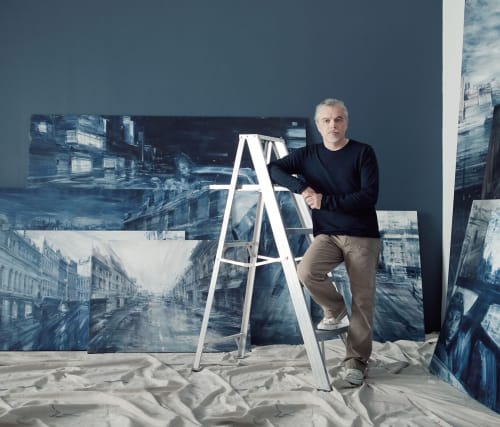After his high school diploma in classical studies, he started a period of intense pictorial research from 1980 to 1986.
At the end of the 1980s, Alessandro Papetti was focused on the theme of "Ritratti visti dall'alto" ("Portraits as seen from above"): this wide-angle view of reality was followed by a cycle of paintings, created between 1990 and 1992, entitled Reperti ("Relics"), in which his attention was more focused on details, like an analytical study on shapes and marks left by time in factory workshops and interiors. From 1992, his research on the theme of industrial archaeology became more in-depth.
In 1995, he met in Paris writer James Lord, biographer of Alberto Giacometti, who dedicated an important critical text to him the following year. During this period, he worked simultaneously on the themes of interiors and portraits, especially studies and nudes, which were selected for the shows Die Kraft der Bilder at Martin-Gropius-Bau in Berlin in 1996, and Sui Generis at PAC in Milan, curated by Alessandro Riva.
These researches, associated to his need to "get out" and to broach the "container" with a different psychological attitude, led him to create the paintings of the cycle "Acqua" ("Water") from 1998 onwards: bodies suspended motionless in swimming pools, or - as in the series "Il bagno di notte" ("Night-swimming") - caught just before plunging into the blackness of a sea illuminated by a livid and lunar light, that were some of his first images of figures in outdoor settings. After these two cycles came the "Cantieri navali" ("Shipyards"): industrial ports, dry docks, gigantic hulls and bodies of ships shown in all their grandeur and fragility.
In 2005, Fondazione Mudima dedicated a retrospective of his work entitled Il disagio della pittura that gathered paintings from the last twenty years, from "Testorian" figures viewed from above to his latest series named "Città" ("City"). In the latter, he executed quick portraits of urban landscapes, like "fast passages" through streets before motionless people and buildings: windows represent the passage between inside and outside, from intimate and secret life to the chaos of a space in continual evolution. Throughout these years, Papetti has regularly retraced his steps, revisiting his past pictorial cycles. His interest in industrial archaeology led him to the production of a series of paintings devoted to the former Renault factory in Seguin Island, exhibited in 2007 at Musée des Années 30 in Boulogne-Billancourt.
In 2009, the Palazzo Reale in Milan hosted his exhibition Il Ciclo del tempo, curated by Achille Bonito Oliva. In an installation of three paintings mounted on circular structures of 3.3m height with a diameter of 8m, viewers are invited to enter and immerse themselves in the works on the themes of water, wood and wind.
In 2011 he participated in the Italian Pavilion of the Venice Biennale, L'arte non è cosa nostra, and in the Pavilion of the Republic of Cuba, Cuba mon amour. That same year in September, two of the three circles of Il ciclo del Tempo were installed in the Auditorium in Rome. He also had two important solo shows at that time, Fabbriche dell'utopia at Museum of Architecture - MUAR in Moscow in 2012, and then at Halle am Wasser in Hamburger Banhof in Berlin the following year.
The Palazzo della Penna - Centro di Cultura Contemporanea in Perugia presented in 2014 a cycle of new works in the exhibition La pelle attraverso, curated by Luca Beatrice. Alessandro Papetti investigated in them the skin's ultimate boundaries in large paintings on paper and canvas. In 2015, he took part in Italia docet⎜Laboratorium, a collateral event to the Venice Biennale before his solo show Io abito qui at Istituto Centrale per la Grafica in Palazzo Poli in Rome, including some works executed in situ. On that occasion, Sky Arte produced a documentary about his latest pictorial research.
The MARCA - Museo delle Arts di Catanzaro dedicated an exhibition to him in 2017, Paesagginterni, whose title is made up of a neologism from the terms landscape and interior. These paintings evoke more mental places than natural ones, such as a need to free himself from the physical limit which characterizes the painted environments, protagonists of his previous series. An overview of the Paesaggiointerno installation was exhibited in the booth of Intesa Sanpaolo at Miart 2018. The complete work, entered in the collections of the bank and then exhibited in their historic buildings in Venice and Naples before returning to Milan, is composed of four large paintings (one landscape and three interiors) and aims to create a difference in relationship and perception between the spectator and two different situations, two antithetical environments, one very open and the other closed, intimate, private.
In 2024 on the occasion of Gorizia - European Capital of Culture 2025, he was invited to participate in two exhibitions curated by Marco Goldin: Ungaretti poeta e soldato. Il Carso e l'anima del mondo. Poesia, pittura e storia in Gorizia and Da Boccioni a Martini. Arte nelle Venezie al tempo di Ungaretti in Monfalcone.
